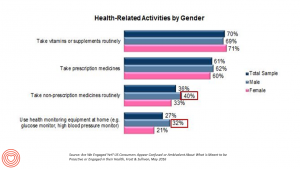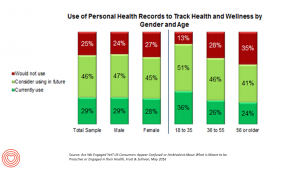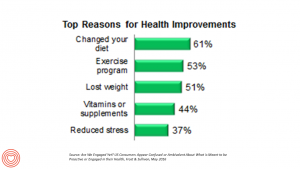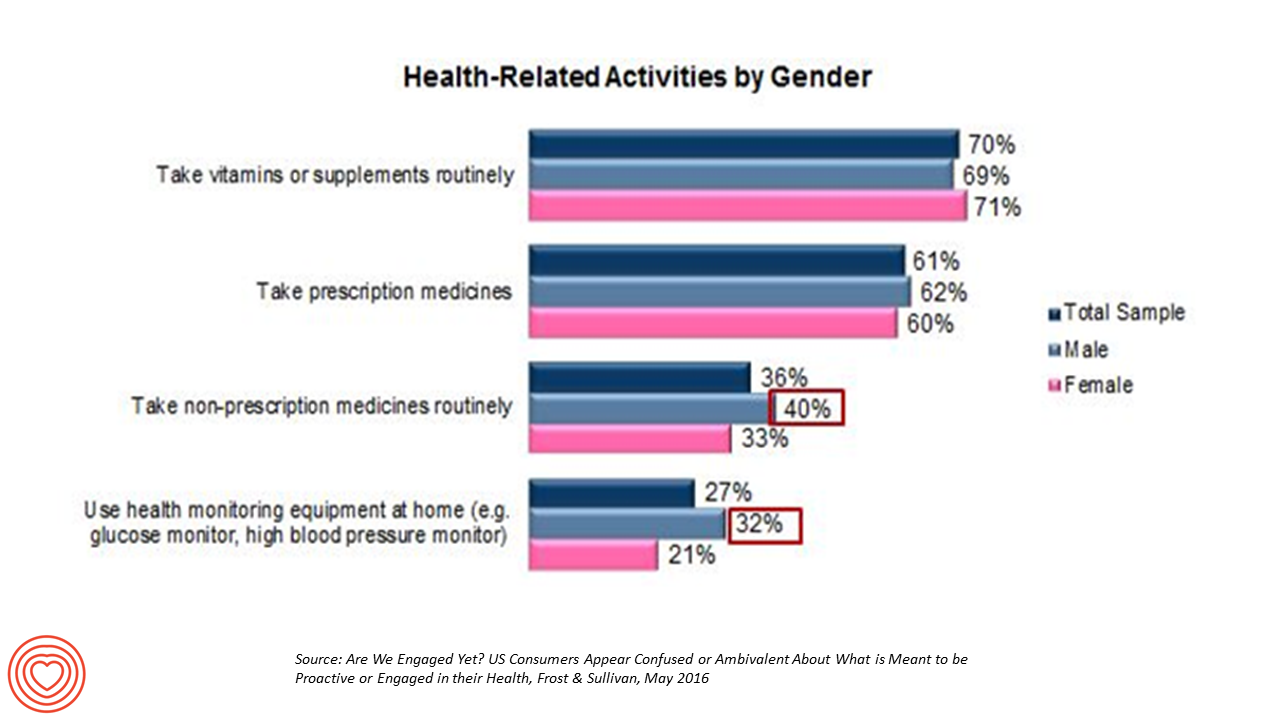
The top health-related activities among U.S. adults include routinely taking vitamins and supplements, and prescription medicines, according to Frost & Sullivan’s report, Are We Engaged Yet? Their response to the titular question lies in in the subtitle: “US consumers appear confused or ambivalent about what it means to be proactive or engaged in their health.”
1 in 2 U.S. adults says they’re “somewhat engaged” in their healthcare, according to Reenita Das’s write-up on the study in Forbes magazine. She notes that:
- Consumers with higher incomes have more confidence in their access to health care services and quality of care
- Budget-constrained consumer are more likely to face healthcare challenges especially related to depression/anxiety and hypertension
- There are generational differences with respect to health behaviors and motivational factors for engagement; these variations extend to interest in mobile apps and wearable technology, and expectations for communications and customer service, both factors in greater demand among younger patients.
- There are Mars-and-Venus gender difference related to the use of health monitoring equipment at home, which more men than women use: 32% men, 21% women, shown on the bottom line in the first bar chart.
 Health engagement also extends to embracing our personal health information. The second chart shows the use of personal health records to track health and wellness by gender and age. While there aren’t major Mars/Venus issues here, there are generational issues: more younger people age 18 to 35 years of age currently use PHRs (think: portals and other consumer-facing digital health records such as those associated with mobile health apps) than people 56 and older (24%). More younger people would also consider using PHRs in the future compared with older people, as well. Fully one-third of people 56 or older say they would never use personal health records to track health and wellness.
Health engagement also extends to embracing our personal health information. The second chart shows the use of personal health records to track health and wellness by gender and age. While there aren’t major Mars/Venus issues here, there are generational issues: more younger people age 18 to 35 years of age currently use PHRs (think: portals and other consumer-facing digital health records such as those associated with mobile health apps) than people 56 and older (24%). More younger people would also consider using PHRs in the future compared with older people, as well. Fully one-third of people 56 or older say they would never use personal health records to track health and wellness.

Frost & Sullivan polled 1,500 U.S. health-insured adults for this research.
Health Populi’s Hot Points: Citing top reasons for health improvements, consumers first say “changed my diet,” followed by adopting an exercise program and losing weight, shown in the third chart. These responses are echoed in other studies, such as the recent survey conducted by PwC on top reasons why people use wearable tech: it’s exercise, nutrition, and fitness, which we learned from PwC in its work on health wearables discussed here in Health Populi.
Look at the last line on this bar chart — reducing stress as a top reason for health improvement. Frost & Sullivan notes that mental and financial health must be integrated into overall health care strategies for patient engagement going forward. These are major Health Populi and THINK-Health priorities, as well: F&S found that consumers rate their financial situation as the most stressful aspect impacting their health, and especially among women. See my Huffington Post column, “Chief Health Officers: Women in Pain” for more data and context on this public and personal health burden.
The implication for the legacy health system is that financial stressed health consumers will seek care outside of more expensive healthcare channels unless providers clearly articulate their value proposition — what’s the offering, how much does it cost, and what’s the probably impact on my personal health? These will be the questions patients-as-health-consumers will increasingly challenge.
Kudos to Nancy Fabozzi in addition to Reenita for their sound insights in this report.





 I'm in amazing company here with other #digitalhealth innovators, thinkers and doers. Thank you to Cristian Cortez Fernandez and Zallud for this recognition; I'm grateful.
I'm in amazing company here with other #digitalhealth innovators, thinkers and doers. Thank you to Cristian Cortez Fernandez and Zallud for this recognition; I'm grateful. Jane was named as a member of the AHIP 2024 Advisory Board, joining some valued colleagues to prepare for the challenges and opportunities facing health plans, systems, and other industry stakeholders.
Jane was named as a member of the AHIP 2024 Advisory Board, joining some valued colleagues to prepare for the challenges and opportunities facing health plans, systems, and other industry stakeholders.  Join Jane at AHIP's annual meeting in Las Vegas: I'll be speaking, moderating a panel, and providing thought leadership on health consumers and bolstering equity, empowerment, and self-care.
Join Jane at AHIP's annual meeting in Las Vegas: I'll be speaking, moderating a panel, and providing thought leadership on health consumers and bolstering equity, empowerment, and self-care.